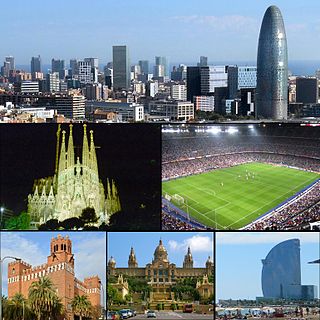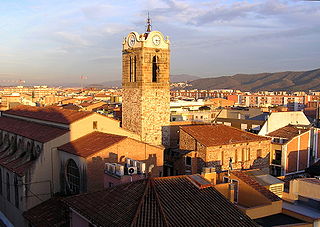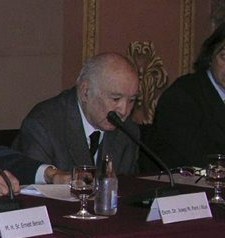| Museu Olímpic i de l'Esport Joan Antoni Samaranch | |
Museum entrance | |
| Established | 2007 |
|---|---|
| Location | Barcelona, Catalonia, Spain |
| Coordinates | 41°21′59″N2°09′25″E / 41.366331°N 2.157064°E |
| Type | Sports museum |
| Website | www.museuolimpicbcn.cat |
The Juan Antonio Samaranch Olympic and Sports Museum (Catalan : Museu Olímpic i de l'Esport Joan Antoni Samaranch, IPA: [muˈzɛw uˈɫimpiɡ i ðə ɫəsˈpɔrd ʒuˈan ənˈtɔni səməˈraŋ] ) opened in 2007 at the Olympic Ring in Barcelona, Catalonia, Spain. The museum is located in front of the Lluís Companys Olympic Stadium at the Montjuïc hill. In June 2010 it was renamed in honour of Juan Antonio Samaranch, who was president of the International Olympic Committee from 1980 to 2001 and a key person during the 1992 Summer Olympics, which were held in Barcelona. [1]

Catalan is a Western Romance language derived from Vulgar Latin and named after the medieval Principality of Catalonia, in northeastern modern Spain. It is the only official language of Andorra, and a co-official language of the Spanish autonomous communities of Catalonia, the Balearic Islands and Valencia. It also has semi-official status in the Italian commune of Alghero. It is also spoken in the eastern strip of Aragon, in some villages of Region of Murcia called Carche and in the Pyrénées-Orientales department of France. These territories are often called Països Catalans or "Catalan Countries".

The Anella Olímpica is an Olympic Park located in the hill of Montjuïc, Barcelona, that was the main site for the 1992 Summer Olympics. The major facilities consist of the Olympic Stadium, or Estadi Olímpic Lluís Companys, the Palau Sant Jordi sports hall, the telecommunications tower designed by Santiago Calatrava, the National Physical Education Institute (INEFC) and the Picornell swimming pools. The Joan Antoni Samarach Olympic and Sports Museum is also located in the Olympic Ring.

Barcelona is a city in Spain. It is the capital and largest city of the autonomous community of Catalonia, as well as the second most populous municipality of Spain. With a population of 1.6 million within city limits, its urban area extends to numerous neighbouring municipalities within the Province of Barcelona and is home to around 4.8 million people, making it the sixth most populous urban area in the European Union after Paris, London, Madrid, the Ruhr area and Milan. It is one of the largest metropolises on the Mediterranean Sea, located on the coast between the mouths of the rivers Llobregat and Besòs, and bounded to the west by the Serra de Collserola mountain range, the tallest peak of which is 512 metres high.
Contents
The museum displays high-performance sport competitions, recreational sports, sports in general and sports for disabled people. It shows how sport can promote values, educate, innovate and renew. The museum has a sport idols space with outstanding players. It also hosts an area for mass sport and major events. It includes advanced technology and interactive multimedia installations.
One of the most emblematic collections of the museum was donated by the museum's namesake, Juan Antonio Samaranch.
A namesake is a person named after another, or more broadly, a thing named after a person or thing that first had the name. According to the Oxford English Dictionary, a namesake is also defined as "a person or thing that has the same name as another".
It also includes a temporary exhibition hall and a display of sport in different civilizations. The museum is managed by the Barcelona Olympic Foundation, which is headquartered at the museum.
The museum project was approved by the Barcelona city council in 2005. The museum opened on March 21, 2007. [1]















